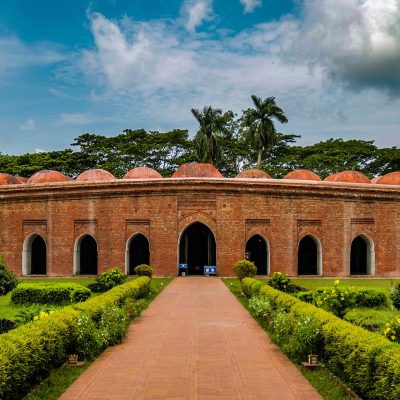
60 Dome Mosque
The sixty Dome Mosque is a mosque located in Bagerhat, which is a part of UNESCO world heritage site. It is the largest mosque of Bangladesh which was made on Sultanate period. The timeline was from 1204 to 1576. When the Bengal Sultanate was in Bengal by Ulugh Khan Jahan, the mosque was built during that period. The mosque is one of the most impressive Muslim monuments in the whole of the Indian Subcontinent.
A Muslim colony was founded in the middle of 15th century, it was located near the Sundarban. A saint general Khan Jahan Ali found the place. He adorned the city with more than one dozen of mosques. Sixty dome mosque is one for them. The construction was started in 1442 and was completed in 1459. The mosque was made for prayers, madrasa and assembly hall.
The mosque is unusually thick and tapered brick in the Tuhglag style and a hut shaped roofline was there. The length is 49 meters in tall and 33 meters in width. There are four towers and the total dome numbers are 81. 77 low domes are are arranged in seven rown of eleven and one big dome on each of the corner. So in total the domes are is 81 in number. The interior is divided into many isles, which culminate in numerous arches. Two towers among four were used to call azan. The vast prayer hall is provided with 11 arched doorways on east. 7 longitudinal aisles and 11 deep bays by a forest of 60 slender stone columns, from which springs rows of endless arches, supporting the domes. 1.8 m (6 ft) thick, slightly tapering walls and hollow and round, almost detached corner towers, resembling the bastions of fortress, each capped by small rounded cupolas, recall the Tughlaq architecture of Delhi.The mosque represents wonderful archeological beauty which was the signature in the 15th century.
The mosque has 77 squat domes with 7 four-sided pitched Bengali domes in the middle row. The vast prayer hall, although provided with 11 arched doorways on east and 7 each on north and south for ventilation and light, presents a dark and somber appearance inside. It is divided into 7 longitudinal aisles and 11 deep bays by a forest of 60 slender stone columns, from which springs rows of endless arches, supporting the domes. 1.8 m (6 ft.) thick, slightly tapering walls and hollow and round, almost detached corner towers, resembling the bastions of fortress, each capped by small rounded cupolas, recall the Tughlaq architecture of Delhi. The mosque represents wonderful archeological beauty which was the signature in the 15th century.
The natural setting of this densely located religious monument along with the medieval form are intact. With the residence, roads, ancient ponds, tombs and chillakhana make the history which contains all of these. The attributes of the city are still preserved.
The oblong shaped prayer hall measuring externally 48.95 m by 32.35 m with a 2.43 m thick surrounding brick wall. Internally divided into seven bays and eleven aisles. The central aisle is wider and higher than the others. The eastern wall consists of a row of eleven poited arch openings. Which was used as the entrance. In the northern wall, an evidence of perforated brick is visible.The right aisle of the central mihrab niche has an off centered arched doorway also. The provision of an entrance, adjacent to the central mihrab niche in the kibla wall, indicates that the Khan Jahan Ali's residence was located to the west or north-west side.
To reach 60 dome mosque, you will have to go to Bagerhat by bus. From the busstand you will find buses, microbuses, CNG, auto rickshaw to reach 60 dome mosque. This is just beside the road, you can see from the car also. The natural beauty and the mesmerizing architecture will mesmerize you.
